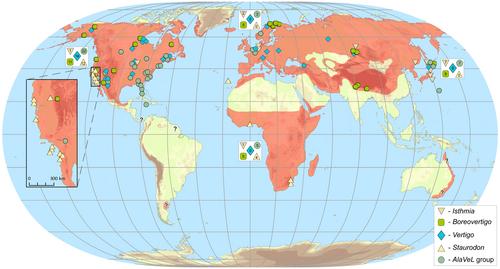We aimed to understand how biogeographical processes and moisture niche ecology contributed to the spatio-temporal diversification dynamics in the land snail genus Vertigo.
Global (North America, Europe, Asia, Africa).
Cenozoic era.
Minute terrestrial snails of the genus Vertigo.
We reconstructed a time-calibrated phylogeny of 94 Vertigo taxa (~85% of all known extant species) based on mitochondrial and nuclear DNA data. Leveraging this phylogeny with distributional and ecological data from >7000 populations, we performed biogeographic and ecological modelling to investigate evolutionary mechanisms of global Vertigo diversification.
Vertigo has diversified since the Early Eocene, ca. 47.6 Ma (95% HPD = 46.0–52.7), with its six subgenera originating from the Late Eocene (30.2–48.7 Ma) to the Early Miocene (13.3–23.0 Ma). Species diversity accumulated linearly, with a slight increase 35–30 and 25–20 Ma, coinciding with the emergence of most subgenera and northern hemisphere cooling, respectively. Biogeographic modelling indicated that most diversification events occurred in sympatry (no range modification), but that rare founder events drove global diversification. Soil moisture conditions, a major variable defining Vertigo niches, displayed significant phylogenetic signal, but varied less among subgenera relative to within. Shifts in biogeographical ranges and moisture niches (or the absence thereof) were significantly associated at macroevolutionary scales, with most niche shifts upon sympatric cladogenesis and hardly any upon founder-event speciation.
Our results indicate that ecological shifts in soil moisture niches occasionally drove cladogenesis in sympatry and anagenetic range extensions, but that long-distance dispersal was mainly successful in the absence of such shifts. A combination of neutral (founder events and drift) and selective mechanisms (adaptive habitat shifts) has determined the macroevolutionary success of Vertigo. Our results imply that species with high niche fidelity or fewer opportunities for long-distance dispersal will be more vulnerable to future anthropogenic stressors.



